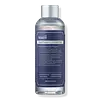What's inside
What's inside
 Key Ingredients
Key Ingredients

No key ingredients
 Benefits
Benefits

 Concerns
Concerns

No concerns
 Ingredients Side-by-side
Ingredients Side-by-side

Water
Skin ConditioningDipropylene Glycol
Humectant1,2-Hexanediol
Skin ConditioningPropanediol
SolventGlycerin
HumectantGlycereth-26
HumectantPanthenol
Skin ConditioningBetula Platyphylla Japonica Juice
Skin ConditioningCorchorus Olitorius Leaf Extract
Skin ConditioningMonarda Didyma Leaf Extract
Skin ConditioningSalvia Officinalis Leaf Extract
CleansingPhytosphingosine
Skin ConditioningBeta-Glucan
Skin ConditioningHydroxyethylcellulose
Emulsion StabilisingCarbomer
Emulsion StabilisingPEG-40 Hydrogenated Castor Oil
EmulsifyingOctyldodeceth-16
EmulsifyingTromethamine
BufferingTrisodium EDTA
Ethylhexylglycerin
Skin ConditioningParfum
MaskingWater, Dipropylene Glycol, 1,2-Hexanediol, Propanediol, Glycerin, Glycereth-26, Panthenol, Betula Platyphylla Japonica Juice, Corchorus Olitorius Leaf Extract, Monarda Didyma Leaf Extract, Salvia Officinalis Leaf Extract, Phytosphingosine, Beta-Glucan, Hydroxyethylcellulose, Carbomer, PEG-40 Hydrogenated Castor Oil, Octyldodeceth-16, Tromethamine, Trisodium EDTA, Ethylhexylglycerin, Parfum
Water
Skin ConditioningButylene Glycol
HumectantDimethyl Sulfone
SolventBetaine
HumectantCaprylic/Capric Triglyceride
MaskingNatto Gum
Sodium Hyaluronate
HumectantDisodium EDTA
Centella Asiatica Extract
CleansingGlycyrrhiza Glabra Root Extract
BleachingPolyquaternium-51
Skin ConditioningChlorphenesin
AntimicrobialTocopheryl Acetate
AntioxidantCarbomer
Emulsion StabilisingPanthenol
Skin ConditioningArginine
MaskingLuffa Cylindrica Fruit/Leaf/Stem Extract
Skin ConditioningBeta-Glucan
Skin ConditioningAlthaea Rosea Flower Extract
Skin ConditioningAloe Barbadensis Leaf Extract
EmollientHydroxyethylcellulose
Emulsion StabilisingPortulaca Pilosa Extract
Skin ConditioningPortulaca Oleracea Extract
Skin ConditioningLysine Hcl
Skin ConditioningProline
Skin ConditioningSodium Ascorbyl Phosphate
AntioxidantAcetyl Methionine
Skin ConditioningTheanine
EmollientCopper Tripeptide-1
Skin ConditioningWater, Butylene Glycol, Dimethyl Sulfone, Betaine, Caprylic/Capric Triglyceride, Natto Gum, Sodium Hyaluronate, Disodium EDTA, Centella Asiatica Extract, Glycyrrhiza Glabra Root Extract, Polyquaternium-51, Chlorphenesin, Tocopheryl Acetate, Carbomer, Panthenol, Arginine, Luffa Cylindrica Fruit/Leaf/Stem Extract, Beta-Glucan, Althaea Rosea Flower Extract, Aloe Barbadensis Leaf Extract, Hydroxyethylcellulose, Portulaca Pilosa Extract, Portulaca Oleracea Extract, Lysine Hcl, Proline, Sodium Ascorbyl Phosphate, Acetyl Methionine, Theanine, Copper Tripeptide-1
 Reviews
Reviews

Ingredients Explained
These ingredients are found in both products.
Ingredients higher up in an ingredient list are typically present in a larger amount.
Beta-Glucan is a polysaccharide. It can be derived from the cell walls of seaweed, oats, yeast, and fungi. It hydrates the skin and helps boost your skin's natural barrier.
As an antioxidant, beta-glucan helps fight free-radicals. Free-radicals are molecules that may damage your skin cells, such as pollution.
Studies show this ingredient may be an effective wrinkle reducer as it can deeply penetrate into skin. It has also been show to help with wound healing.
Learn more about Beta-GlucanCarbomer is a polymer of acrylic acid. Its main role is to create a gel consistency.
A high amount of carbomer can cause pilling or balling up of products. Don't worry, most products contain 1% or less of carbomer.
Hydroxyethylcellulose is used to improve the texture of products. It is created from a chemical reaction involving ethylene oxide and alkali-cellulose. Cellulose is a sugar found in plant cell walls and help give plants structure.
This ingredient helps stabilize products by preventing ingredients from separating. It can also help thicken the texture of a product.
This ingredient can also be found in pill medicines to help our bodies digest other ingredients.
Learn more about HydroxyethylcellulosePanthenol is a common ingredient that helps hydrate and soothe the skin. It is found naturally in our skin and hair.
There are two forms of panthenol: D and L.
D-panthenol is also known as dexpanthenol. Most cosmetics use dexpanthenol or a mixture of D and L-panthenol.
Panthenol is famous due to its ability to go deeper into the skin's layers. Using this ingredient has numerous pros (and no cons):
Like hyaluronic acid, panthenol is a humectant. Humectants are able to bind and hold large amounts of water to keep skin hydrated.
This ingredient works well for wound healing. It works by increasing tissue in the wound and helps close open wounds.
Once oxidized, panthenol converts to pantothenic acid. Panthothenic acid is found in all living cells.
This ingredient is also referred to as pro-vitamin B5.
Learn more about PanthenolWater. It's the most common cosmetic ingredient of all. You'll usually see it at the top of ingredient lists, meaning that it makes up the largest part of the product.
So why is it so popular? Water most often acts as a solvent - this means that it helps dissolve other ingredients into the formulation.
You'll also recognize water as that liquid we all need to stay alive. If you see this, drink a glass of water. Stay hydrated!
Learn more about Water